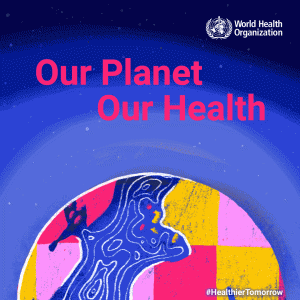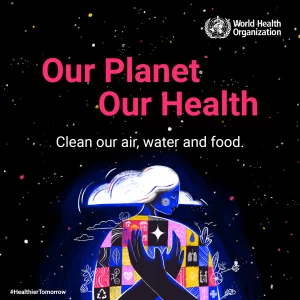World Health Day 2022 highlights the link between our livers and the planet
7 April 2022
On World Health Day, EASL explores the complex relationship between the well-being of the planet and that of our livers.
What is World Health Day?
On 7 April, every year, we celebrate World Health Day. On this date, marking the anniversary of the founding of the World Health Organization (WHO) in 1948, the WHO draws global attention to a particular public health topic.
What is the theme of World Health Day 2022?
In 2022, the World Health Day topic is: Our planet, our health. Our health depends on our planet, just as its health depends on us. Our overall well-being, including the health of our livers, is intertwined with the health of the planet around us. The WHO is calling for a #HealthierTomorrow and for us to create societies focussed on well-being.
How does the environment damage your liver?
Climate change and resulting extreme weather scenarios (such as heat, fires, flooding, pollution, and droughts) can negatively affect agriculture, how food is grown, how our societies function, and the places we live in. Not only that, climate change can cause harm to our mental and physical health, including our livers.
This set of knock-on effects is called the climate change–liver disease connection.
Food insecurity triggered by global warming has led to epidemics of both obesity and undernutrition, both of which can cause damage to the liver, notably causing non-alcohol related fatty liver disease (NAFLD). NAFLD in turn can lead to further liver disease, including cirrhosis and liver cancer,
said Prof. Aleksander Krag, EASL Vice-Secretary.
The multifaceted relationship between climate change and liver disease
Source: “The negative bidirectional interaction between climate change and the prevalence and care of liver disease”, Donnelly et al, Journal of Hepatology, March 2022
Other environmental sources of damage to the liver include: fungi in food, typical in hotter climates; outbreaks of parasites that thrive in rivers and along coastlines; contaminated drinking water; waterborne viral infections, including hepatitis; and extreme heatwaves and heatstroke. Air pollution appears to cause inflammation, making it harder for the liver to heal itself, as discussed in a recent article published in the Journal of Hepatology. Stress and eco-anxiety may drive people to consume more alcohol and drugs, which puts further strain on the liver.
How does liver treatment damage the environment?
The healthcare industry takes a heavy toll on the environment. In what it does, and what it does not do. The healthcare sector is the source of considerable greenhouse gases, medical packaging, transport, and waste, and sometimes unnecessary medical procedures.
The prestigious EASL–Lancet Commission report, published end-2021, is calling urgently for a paradigm shift in tackling liver health across Europe, which could also reduce the negative climactic impact of the health sector,
commented Prof. Thomas Berg, EASL Secretary General.
How is EASL addressing the climate change–liver disease connection?
Together with three other professional associations devoted to the liver and the digestive systems, EASL has just published a Commentary exploring the links between climate change, liver disease, and healthcare for liver patients. EASL Vice-Secretary, Prof. Aleksander Krag is a contributing author.
“The negative bidirectional interaction between climate change and the prevalence and care of liver disease: A Joint BSG, BASL, EASL, and AASLD Commentary” was published in March 2022 simultaneously in three medical journals, including EASL’s Journal of Hepatology.
The Commentary urges the healthcare sector to take responsibility for its role in climate change and to seek creative solutions. It proposes a four-domain strategy prevention, patient empowerment and self-care, lean service delivery, and provision of low-carbon alternatives. It provides a summary table, “Suggested Actions for Environmentally Sustainable Hepatology”, outlining the steps that can be taken by individual doctors, departments, specialist societies, and pharma and industry, and set of Calls to Actions (see below).
As the hepatology community, we need to make medical services more sustainable and less wasteful (such as by reducing the use of invasive tests, when non-invasive alternatives exist), opting for telemedicine when appropriate, and reducing travel.
In our interaction with society, the healthcare community can help educate the public about the links between the environment and their own liver health: promoting prevention, rather than cure. We additionally have a responsibility to lobby for changes at a policy level to make healthy eating and living easier to do. EASL, for example, is actively involved in the fight against the marketing of nutritionally poor food to children.
Calls to Action
In the recently published joint Commentary, EASL and three other associations call for hepatologists worldwide to:
- raise awareness of the reciprocal link between climate change and liver disease, which includes instruction in medical school and specialty training;
- facilitate research into the impact of climate on the liver and liver-related health care;
- promote awareness of how ways of living can impact positively on the prevention of liver disease and the climate crisis, and advocate for such behavioural changes;
- reduce low-value healthcare contacts in hepatology, for example, reduce unnecessary in-person visits and procedures;
- promote sustainable hepatology services and good practice to colleagues, mostly via virtual conferences, symposia, and small-group interactive meetings interspersed with occasional safe, in-person, morale-boosting, small, educational and social gatherings;
- develop standardised sets of sustainability metrics specific to hepatology; and
- advocate for government investments, for example, policies to reduce the harmful impact of alcohol, ban marketing of junk foods, subsidise healthy foods, and make exercise free and accessible to all.
Source: “The negative bidirectional interaction between climate change and the prevalence and care of liver disease”, Donnelly et al, Journal of Hepatology, March 2022
More EASL actions underway
Access the EASL–Lancet Commission report
Read an article on air pollution and the liver, published end-2021 in the Journal of Hepatology
View the joint statement, recently signed by EASL and 16 other organisations: Call to protect children from the marketing of nutritionally poor food: Time for an effective regulatory framework
Access the HEPAHEALTH Project Report: Risk Factors and the Burden of Liver Disease in Europe and Selected Central Asian Countries
Read more about EASL’s Policy and Public Health Committee
Find out more about EASL’s EU Affairs and Advocacy activities




